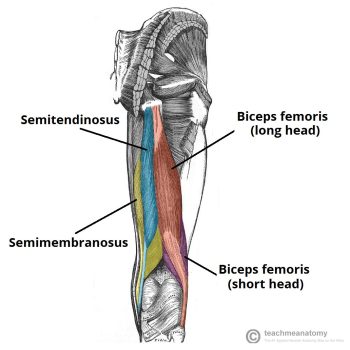FIFA Women’s World Cup just a week away
HAMSTRING MUSCLE INJURY

Luke Blunden
APA Sports and Exercise Physiotherapist
Strength and Conditioning Coach
Australia’s FIFA Women’s World Cup team has been selected. A squad of 23, ranging in age from 21 (Kyra Cooney-Cross) to 38 (Aivi Luik). Our named captain is arguably the worlds best player, Sam Kerr and our vice-captain is Steph Catley. Our least experienced international representative is Clare Hunt having played just 5 matches for Australia, and our most capped player is Clare Polkinghorne with 156 matches. Only three of our players are currently playing for local teams, with the other 20 playing for teams from England, Sweden, USA, Norway and France. A great mix of talent and experience that we hope to see progress far into the tournament. But any player can suffer soft tissue injuries. Our independent practitioners will be watching the tournament intently, hoping all Australians remain injury free. They are all trained to treat elite athletes from any sport and plan their recovery and return to sport. The complimentary specialties that they offer, including Physiotherapy, Sport & Exercise Medicine, Exercise Physiology, Psychology and Myotherapy as well as immediate access to orthopaedic surgeons and practice nurses, provide all levels of athletes with healthcare options best suited to their needs.
This blog is the third in a series brought to you throughout the tournament where Ballarat Sports Medicine and BallaratOSM will focus on common injuries in soccer. In this blog we focus on Hamstring muscle injury
Hamstring injuries are one of the most common injuries in football. A hamstring injury is a strain or tear to the group of muscles at the back or posterior aspect of the thigh that occurs when one or more of the three muscles are strained or pulled beyond their capacity. Sports Medicine Physician Dr Ian Beasley from the Aspetar Sports and Orthopaedic centre of excellence provides a good overview here.
Anatomy
The three hamstring muscles are biceps femoris, semitendinosis and semi membrenosis. Each of these three muscles act together in their function however have differing anatomical function to allow the body to perform different elements of sporting performance. The attachments sites, muscle and tendon structure of the muscles differ and are specifically designed for a particular function and work in conjunction with other systems in the body. The hamstring muscle which crosses the knee and hip joint in basic terms acts to flex (bend) the knee and extend the hip when contracted in a shortening (concentric) action, however in a more dynamic context it also is involved in knee extension, hip flexion, rotation of the thigh and stability. A comprehensive understanding in how the hamstring muscle works is important in maximising recovery and performance.

Injury Grading
Hamstring muscles injury can be graded according to their severity;
- Grade 1: Mild injury
- Grade 2: A partial muscle tear
- Grade 3: A complete muscle tear
The severity of injury will determine the degree of healing and recovery time required.
Signs and symptoms
- Sudden and severe pain during exercise along with a snapping or popping feeling.
- Pain in the posterior thigh or buttock when walking, bending over or straightening the leg.
- Swelling and tenderness, immediate or over a period of a few hours. A gap in muscle fibres may be palpable.
- Bruising of discoloration around the muscle.
- Muscle weakness or an inability to weight bear on the injured leg.
Causes
Injury is typically caused from direct (contusion) or indirect (strain or distension) mechanisms. A contusion injury usually occurs from a direct blow from an opponent causing a ‘corkie’ where the opponent compresses the muscle between them and the players thigh bone.
A strain or tear is when the demands of the task the athlete is performing exceeds the capacity of the muscle unit.
Hamstring injury is associated with sports that involve;
- Rapid acceleration or deceleration
- Jumping
- Cutting
- Pivoting
- Turning
- Kicking
- Sprinting
Re injury of the hamstring muscle is common and can be a vicious cycle for athletes effected in terms of pain and dysfunction, reduced performance and time lost from sports.
Risk factors
- Age
- History of hamstring injury
- Poor hamstring flexibility
- Poor hamstring strength
- Sports participation
- Concussion
Diagnosis
Diagnosis of hamstring injury begins with a clear history from the player, then a thorough physical examination that includes careful examination of range of motion and muscle contraction.
X-ray images can check for an associated avulsion fracture, while an ultrasound or MRI can visualise injury in the muscles or tendon. An MRI scan is a useful tool to determine the exact location and extent of injury.
Treatment
Most hamstring muscle injuries will be treated by a Physiotherapist with only a small amount requiring surgical intervention.
The initial goals of treatment will be;
Reduce pain and swelling
-
- Rest, ice, compression, and elevation
Restore mobility and walking
-
- Physiotherapy will guide the athlete on techniques and strategies to achieve this.
Restore flexibility and muscle strength
-
- Physiotherapy with tailor a recovery program to optimise the recovery of your specific injury pattern. The type and location of hamstring injury will determine the approach. A comprehensive understanding of the patho-anatomy is required.
Restore function and performance
-
- Physiotherapy will progress the capacity of the hamstring muscles and the athlete to return the athlete to full function and sporting performance. Knowledge of Hamstring pathology, unique hamstring anatomy, physical preparation methods and individual sports will maximise results.
Surgery is required if the muscle is pulled away from its origin or insertion at the pelvis or shin bone or in some severe cases of tear to the muscle fibres. At Ballarat OSM we have a clear protocol for post operative management after hamstring surgery to return athletes to sport.
Return to sport
Our Physiotherapists in conjunction with the sports medicine team, athlete, coach, and parent will facilitate return to sport.
Common criteria for return to sport may include;
- Pain free function.
- Restoration of muscle strength, flexibility, and function.
- A restoration of function to withstand the demands of sporting activity.
Prevention
Injury prevention is more desirable than muscle injury however is not usually given enough focus in community sport. Sports medicine teams will consider the injury profile of the sport and individual athletes when developing programs. For hamstring injuries prevention begins with considering the risk factors to injury and working on the modifiable risk factors.
Specific hamstring strengthening and sprinting are two well discussed areas for focus.
Some hamstring injury prevention programs that have been successfully implemented in elite and community sport can be found here and include Footy first, the netball knee program, FIFA 11+, and Prep to Play.
Ballarat Sports Medicine has elite Sports and Exercise Medicine Physicians, APA Sports and Exercise Physiotherapy and Advanced Exercise Physiology clinicians who can assist you with prevention or management of hamstring injury in life or sport.



